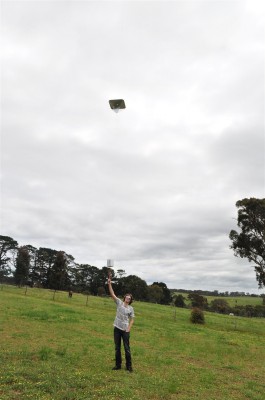Horus 10
Technical information:
| Launch date | 15/11/2010, 12:00 pm |
| Landing date | 15/11/2010, 3:30 pm |
| Flight duration | ~ 3.5 hours |
| Launch site | -35.1276, 138.8477 |
| Landing site | -35.9019, 140.6104 |
| Flight path | Web, KMZ |
| Distance travelled |
181.5 km |
| Maximum altitude | 17,385 m |
| Average ascent rate | 1.5 m/s |
| Impact speed | 5 m/s |
| Payload weight | 200g |
| Flight computer | Nut 1.1 flight computer |
| GPS module | Falcom FSA03 |
| Radio transmitter | Radiometrix NTX2 25mw |
| Telemetry | 300 baud RTTY, CRC16 checksum |
| Tracking | Ground stations (distributed listener), 1 chase car, web based tracker |
Details:
Horus 10 was a test flight - I wanted to test a new piece of tracking software I'd put together, an offline version of the CUSF landing predictor which ties in with our offline tracking systems.
Besides telemetry, no experiments were flown. The balloon used was far smaller than usual, and was expected to burst at approx 15km altitude. Our predictions had factored in a 5m/s ascent rate and put the balloon landing a reasonable distance from launch - retrievable in an hour or two.
Launch:
Given the simplicity of this flight, preparation was very simple. Weather on the day was overcast, though winds were low. The balloon filling and payload assembly took place in a field that we've previously launched from. Once ready, the payload was tethered to a nearby fence, the car was packed, then the balloon released.
Flight:
Once launched, it became evident that the balloon's ascent rate was lower than hoped. As we found in the past, accurately predicting ascent rates on such small balloons is difficult. The slower ascent rate meant that the balloon would travel much further - our predictions suggested it might even pass into Victoria.
Asides from a few early glitches, our tracking systems and the new offline predictions worked well. Balloon burst occurred at ~17km (higher than expected) - from that point onwards the predictor gave very consistent results. Later analysis showed that the accuracy was excellent:
Ascent:
- 0km - 10km altitude: within 50km of actual landing site
- 10km - 17km altitude: within 20km of actual landing site
Descent:
- 17km - 10km altitude: within 5km of actual landing site
- 10km - 5km altitude: within 2km of actual landing site
- < 5km altitude: within 1km of actual landing site
Recovery:
Recovery of Horus 10 was not as straightforward as had been hoped. The payload landed 1-2km inside Ngarkat conservation park, a sandy soiled native vegetation reserve. The initial route taken got us within ~6km of the payload before the roads became impassable - it was decided to explore an alternate route rather than spend half the day walking.
The second route wasn't much better, and against better judgement we attempted to reach the payload via the South border track. Of course, within 5km we became bogged when the track changed from hard packed clay to loose sand.
A few hours were spent in moderately successful attempts to free the car, only to get bogged again. After exhausting the options we had available (and breaking the jack), we decided to walk back to the main road to find someone with a more suitable equipped vehicle to pull us free.
Very fortunately for us, the first people to find us on the Bordertown Pinnaroo road were happy to help, and easily pulled us out of the sand - a huge thanks to Michael and Di for rescuing us!
With the car freed and the light failing, we headed back to Keith for some dinner & to contemplate how we might retrieve the payload. At that point, our regular chase team member Matt gave me a call and mentioned he and his wife had a few local contacts in the Coorong Council area, and that he'd see if he could call in a favour. Within the hour, Matt & Faith's friend Graham (who happens to work for the local Coorong council) picked us up from the Keith hotel in his 4WD and took us back out into the park, where we retrieved the payload at around 10:30pm - expeditions out into Ngarkat at night without local knowledge are certainly not recommended. Thanks Graham!
Conclusions:
This launch gave us a great opportunity to test the offline predictor (and fix a couple of bugs) without having to worry too much about losing an important payload. The predictor worked as expected, and gave very accurate results - it's certainly something that will make recovery easier in future.
A huge thanks goes out to those who saved us on this launch - without the help of Michael, Di, Matt, Faith & Graham we wouldn't have been able to retrieve the payload. ![]()


